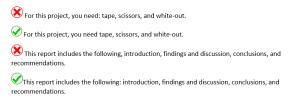4.12 Lists
Jordan Smith; Melissa Ashman; eCampusOntario; Brian Dunphy; and Andrew Stracuzzi
Lists are useful because they emphasize selected information in regular text.
Lists can be horizontal, with the listed items included directly in the sentence or paragraph. Lists can also be vertical, such as when you see a list of three or four items presented vertically on the page rather than in normal paragraph format. Lists–particularly vertical lists–are noticeable and readers are likely to pay more attention to them. Certain types of lists also make for easier reading. For example, in instructions, it is a big help for each step to be numbered and separate from the preceding and following steps. Lists also create more white space and spread out the text so that pages don’t seem like solid walls of words.
Like headings, the various types of lists are an important feature of professional writing. They help readers understand, remember, and review key points. They help readers follow a sequence of actions or events. They also break up long stretches of straight text.
General guidelines
Follow these guidelines for effective use of lists:
- Use lists to highlight or emphasize text or to enumerate sequential items.
- Use a lead-in phrase or sentence to introduce the list items and to indicate the meaning or purpose of the list.
- Make sure that each item in the list reads grammatically with the lead-in.
- Make list items parallel in phrasing.
- Avoid overusing lists because using too many lists destroys their effectiveness.
Bullet points are used when each item in a bulleted list is of equal importance. This use is in contrast to numbered lists where items may have different levels of importance, priority, or sequence. Use bulleted lists for items that are in no required order. Use numbered lists for items that are in a required order (such as step-by-step instructions) or for items that must be referred to by item number.
Horizontal lists
When creating a horizontal list,
- Use a colon to introduce the list items only if a complete sentence precedes the list. Omit the colon if the lead-in is not a complete sentence.

- Use both opening and closing parentheses on horizontal list item numbers or letters: (a) item, (b) item, etc. (Don’t just use one parenthesis.) Use either regular numbers or lowercase letters within the parentheses.
- Use lowercase letters for the text of in-sentence lists items, except when regular capitalization rules require caps.
- Punctuate the horizontal list items with commas if they are not complete sentences. Use semicolons if they are complete sentences.

- Place the horizontal list at the end of the sentence. Never place a horizontal list introduced by a colon anywhere but at the end of the sentence:

Vertical lists
When using vertical lists,
- Introduce the list with a lead-in phrase or clause. Use a colon to introduce the list items only if the lead-in is a complete sentence. Omit the colon if the lead-in is an incomplete sentence.
- Avoid using headings as lead-ins for lists. Add at least one line of text between the heading and the list.
- Use consistent spacing, indentation, and punctuation.
- Use sentence-style capitalization on list items.
- When possible, omit articles (a, an, the) from the beginning of non-sentence list items.
A word of caution
If your list contains more than 6-8 items, you might consider consolidating list items or re-formatting your list. Lists with too many items can be overwhelming and challenging to read.
Attribution
This chapter contains material taken from “Bulleted and numbered lists” in Online Technical Writing Textbook by D. McMurray and is used under a CC-BY 4.0 International license.

